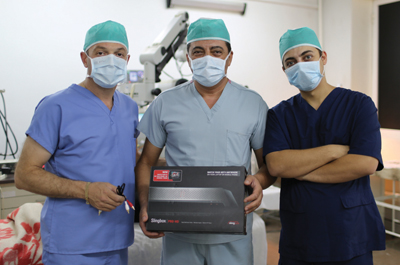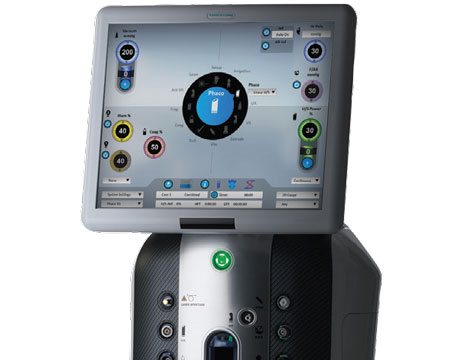One surgeon who is helping to pioneer this effort is Thomas C. Lee, MD, associate professor of ophthalmology and director of both the Vision Center at Children’s Hospital Los Angeles and the Surgical Retina Fellowship at the Keck School of Medicine, University of Southern California. For several years he has worked with Roger Ohanesian, MD, president of the Armenian Eye Care Project, helping to train doctors. “We’ve been deploying online education programs since 2009, primarily to teach doctors in Armenia to diagnose and manage retinopathy of prematurity,” Dr. Lee explains. “At first, they’d use the Retcam platform to image kids’ retinas and then email the images to us, a form of telemedicine called ‘store and forward.’ I’d check my email, upload the image and get back to them.
“However, this didn’t help the patients who failed treatment and needed surgery,” he continues. “They were managing this by sending the children to St. Petersburg, Russia, for the surgery. Without the surgery a child would go blind—but getting a premature child to Russia in an ICU ventilator is not an ideal scenario. So, their government approached us again and asked us to train their doctors to do the surgery.
“At first, they flew their doctors here,” he says. “They’d stay here for six months, watch us manage ROP and then go back to their country. Unfortunately, that system really didn’t work. The doctors weren’t observing their own patients, and they weren’t doing the procedures themselves and developing a level of competency and comfort. So, at their request, we decided to do the reverse, so the doctors could stay in their own country and treat their own patients. Ultimately, we realized they also needed a video support system.
| ||||||
“I knew this arrangement would be challenging, because the most experienced surgeons over here can’t spend an extended time in Armenia,” he notes. “But after some thought I realized that we have the ability to be there virtually. The problem was, we could communicate face-to-face using Skype, but that wasn’t enough. The surgeon at our end needs to be able to see what the surgeon in Armenia is seeing during the surgery in order to make useful comments and suggestions. That was not feasible using Skype, both because of the low-resolution of the signal and the lack of an easy way to get the surgical images into the camera view.”
Making the Connection
Dr. Lee favors the use of endoscopy for performing ROP surgery, although he acknowledges that some surgeons are skeptical of this approach. “Our group has extensive experience with this method and we’ve found it to be safe and effective,” he says. “In any case, the fact that the endoscopic image is two-dimensional and already in the form of a high-definition video signal turned out to be an advantage in this situation; it would be very difficult to share the 3-D view you have through the surgical microscope, but it’s easy to share a 2-D image. What we needed was a way to stream a high-definition copy of the video signal from the endoscopic camera in Armenia to our surgeons in the United States in a way that was affordable. One existing system that could manage this type of video and audio exchange is the Polycom video conferencing system; however, their units cost about $15,000, and we’d need two of them, one at each end. It occurred to me that some other existing technology might be able to meet our needs, perhaps less elegantly, but at a much lower cost.”
The technology Dr. Lee thought of using was the Slingbox, made by Sling Media. “The Slingbox is designed to work between your cable box and TV,” he explains. “The video and audio coming out of the cable box go into the Slingbox, which passes the signal along to your TV but also diverts the signal into its computer. The computer does real-time compression and streams the result out to the Internet at 1080p, 30 frames per second. Once that’s operating, you can log onto the Slingbox signal remotely from anywhere around the world. My guess is that the company has a server that accepts the signal from the Slingbox, so that when you log in you’re logging into their server.
|
“The beauty of this setup is that we only need one Slingbox, which costs about $150—far less expensive than the Polycom alternative,” he says. “The downside is that there’s a delay of about 10 seconds, so what I’m seeing is the endoscopic view from 10 seconds earlier. This limits my ability to respond in real time. If we could get the latency down, I could be more reactive and bring more value to the case, so we’re investigating other platforms to reduce the latency. Nevertheless, I can still provide overall guidance, helping the surgeons strategize their way through the surgery.”
Dr. Lee says that when the surgeons in Armenia have a case they believe would benefit from supervision, they contact Dr. Lee to arrange a date and time. “At the appointed hour I log onto Slingbox and we initiate the Skype video call,” he says. (You can see a video of this in action at https://vimeo.com/89036200.) “To date, we’ve done several cases this way. We do get a decent image using the Slingbox system, despite the fact that is was not designed for this purpose. We’re finding that this system is good enough for me to get an overall sense of the severity of the case, allowing me to offer useful advice regarding the best way to proceed.”
Dr. Lee says that in the near future they will try using a streaming device at both ends. “With that setup, not only will I see them in real time, they’ll see me in real time watching the surgery,” he says. “This will allow me to point out details in the image produced by their endoscope, such as where in the pathology I think they should cut. This will make it easier for me to offer more specific advice, as opposed to just offering overall strategy. In theory, we could do this with Skype, but we haven’t figured out how to get an external webcam to link into the call. If we could tie in an external webcam, we could point the webcam at the computer screen and then I could show them the image they’re streaming me and where I think they should be cutting.”
Dr. Lee notes that, by itself, this arrangement would not constitute sufficient supervision to protect patients from inexperienced surgeon error. “What we’re currently doing is sending a younger doctor to Armenia to act as an onsite attending physician,” he says. “Right now the doctor filling this role is Chien Wong, MD, who trained with me for a year and a half after doing a retina fellowship at Moorefield’s in London. He has less experience than I do, but has a good idea how these cases should be done; he knows the mechanics very well. Thus when I log on and offer advice on a surgery, I’m one of two attending surgeons, supplementing the advice of my younger colleague. This type of arrangement—having a trainee with limited experience at the location while an expert in another location provides overall guidance—could be very useful for training surgeons in remote locations.”
The Future: Coming Fast
Dr. Lee notes that someone might argue that attempting to do this is premature—that the technology is not up to the task yet. “They’d be absolutely right,” he says. “I’d be the last person to say that this is a scalable model that will work all the time, because we’re still trying to figure out what’s safe and what’s feasible. However, given the speed at which technology is developing, it will be there very shortly. Moore’s Law states that every 18 months the number of transistors able to fit onto a chip doubles, and there’s a similar law for bandwidth, called Neilson’s Law, which says the availability of residential bandwidth will double every 18 months. Whether you’re in the United States or sub-Saharan Africa, that law will probably hold true. Furthermore, improved video compression algorithms are letting us fit far more data into the same bandwidth.
“For example, Netflix will soon be streaming a 4K image—four times the resolution of HD—to your home cable box,” he continues. “To me, that’s medical-grade bandwidth. We’re figuring out the workflow and solving some of the problems, so that when the technology is ready—which I think will be in two or three years—we’ll have a platform that will be ready to let us help doctors around the world. Wayne Gretsky, the renowned hockey player, once said that you never skate to where the puck is, you skate to where it’s going to be. That’s what we’re trying to do.”
Regarding how this might be used in countries with less infrastructure, Dr. Lee notes that many of these countries are skipping the earlier communication technologies we’ve lived with for decades, instead moving straight to the latest technology. “In sub-Saharan Africa or Indonesia no one’s bothering to put up cables or wires—they’re going straight to wireless broadband systems,” he says. “I suspect that within a few years, the prevalence of broadband in developing countries will be surprisingly good. A decent 4G signal gives you about as much bandwidth as a cable modem, and the Slingbox can work via Wi-Fi. This change will provide educational opportunities we wouldn’t otherwise have.”
Dr. Lee believes this type of arrangement will make a big difference in how quickly skills can be transferred to other countries. “Currently it takes one or two professional generations to get enough experience to be able to operate successfully on some of these seriously sick children,” he says. “If we can make this system work, we can fast-track the skill set and expertise surgeons can bring to their countries. And once a surgeon is proficient, he can train other surgeons in his country. This has the potential to shorten the learning curve for the entire country. Our work with Armenia is the test case.” REVIEW







